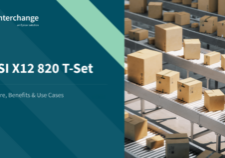The Power of Web EDI for Global Supply Chains
As businesses strive to optimise their operations and enhance collaboration with their partners, the concept of Electronic Data Interchange (EDI) has played a crucial role in streamlining B2B transactions.
However, the traditional approach to EDI, with its complex networks and sometimes high costs, has posed challenges for many organisations.
That’s where EDI web services come into the picture.
In this blog, we will delve into the world of Web EDI and how it can revolutionise your business interactions, helping you stay ahead in the dynamic and interconnected world of global supply chains.
Suggested reading: Want a deeper understanding of EDI is and its applications for businesses? Check out EDI 101 for more information.

What is web based EDI?
Web based EDI (also known as Web EDI or Internet EDI) is a modern approach to electronic data interchange specifically designed to streamline B2B communication in the global supply chain sector.
While traditional EDI relies on proprietary networks and value-added networks (VANs), Web EDI leverages internet technologies to enable secure and real-time data exchange between trading partners.
With Web EDI, organisations can use web-based portals or cloud-based platforms to exchange business documents, eliminating the need for dedicated communication lines or VAN subscriptions.
Unlike traditional EDI, which often involves upfront investments in infrastructure and ongoing maintenance costs, Web EDI offers a more accessible and cost-effective alternative for businesses of any size. Often Web EDI also provides a user-friendly interface accessible through standard web browsers, allowing a non-technical audience to engage with the software.
This democratisation of EDI enables a wider range of organisations to engage in seamless data exchange, fostering collaboration and efficiency throughout their supply chain.
How Web EDI Works
Web-based portals or cloud-based platforms serve as the foundation for Web EDI. These platforms provide a central hub from which users can access the necessary tools and functionalities for document exchange.
The process of document exchange in Web EDI involves three key steps:
- Data Transformation: Business documents are converted from internal formats (such as XML or CSV) into the standardised formats used in EDI, such as EDIFACT or X12. This transformation ensures that the data can be accurately interpreted and understood by the recipient’s systems.
- Validation: The transformed documents undergo validation, which involves checking for compliance with the predefined standards and business rules. Validation helps identify any errors or discrepancies that may exist in the data, ensuring its integrity before transmission.
- Transmission: Finally, the validated documents are securely transmitted over the internet using various protocols such as AS2 (Applicability Statement 2) or FTP (File Transfer Protocol), ensuring that the data reaches the intended recipient in a reliable and timely manner.
The role of messaging standards
Messaging standards play a crucial role in Web EDI: they ensure interoperability and seamless integration between trading partners.
They provide a common language for communication, facilitating efficient collaboration and improving overall supply chain efficiency. Standards such as EDIFACT and X12 are widely adopted in the global supply chain industry.
Messaging standards define the structure, format, and content of different types of business documents, such as purchase orders, invoices, and shipping notices. By adhering to these standards, trading partners can exchange information seamlessly, regardless of the systems or software they use.
Suggested reading: For more information on messaging standards and t-sets, see our messaging standards overview.
Advantages of Web EDI
As you might have already gathered, Web EDI has many advantages over traditional EDI methods:
- Increased Accessibility: Web EDI offers a user-friendly interface accessible through standard web browsers, minimising the number of complex systems businesses require.
- Cost-Effectiveness: Web EDI eliminates the need for costly infrastructure investments and ongoing maintenance associated with traditional EDI approaches. It removes the requirement for dedicated communication lines or VAN subscriptions, resulting in significant cost savings for businesses.
- Real-Time Visibility and Secure Data Exchange: Web EDI leverages internet technologies to enable real-time data exchange, facilitating faster and more transparent B2B transactions. It also ensures the security of data transmission through the use of encryption protocols and secure web-based portals or cloud-based platforms.
- Scalability and Flexibility: Cloud-based platforms used in Web EDI provide scalability, allowing businesses to handle increased data volumes and adapt to changing needs. It offers flexibility in terms of partner onboarding, allowing organisations to easily integrate new trading partners into their EDI network.
- Enhanced Visibility and Accuracy: Web EDI provides improved visibility and tracking of orders, enabling organisations to have real-time insights into the status of their transactions. It reduces errors and improves data accuracy through data transformation and validation processes, ensuring consistent and reliable information exchange.
These advantages enable organisations to optimise their B2B transactions, streamline processes, and stay competitive in today’s interconnected supply chain landscape.
How to best implement Web EDI
While Web EDI is accessible to any business, it is still another layer of complexity to your tech stack. If you want to implement it effectively and reap all the benefits above, then the the best way to do so is by partnering with an EDI expert who can manage it for you.
Data Interchange can guide you through the entire process, from initial setup to ongoing support, so that you can ensure a smooth transition to a Web EDI model.
We work with businesses of any size to make:
- Onboarding suppliers easy so that Web EDI is adopted across your entire supply chain.
- Your supply chain flexible and future proof. From our web portal, you can add and integrate suppliers into your EDI process with ease.
- Order processing consistent so that even the smallest suppliers can provide data back to you the same way as larger suppliers do.
By partnering with Data Interchange, you can focus on your core business while enjoying the advantages of Web EDI – safe in the knowledge that its implementation and management is in capable hands.
Drive efficiency in your supplier management process today. Speak to an expert.



























































































































